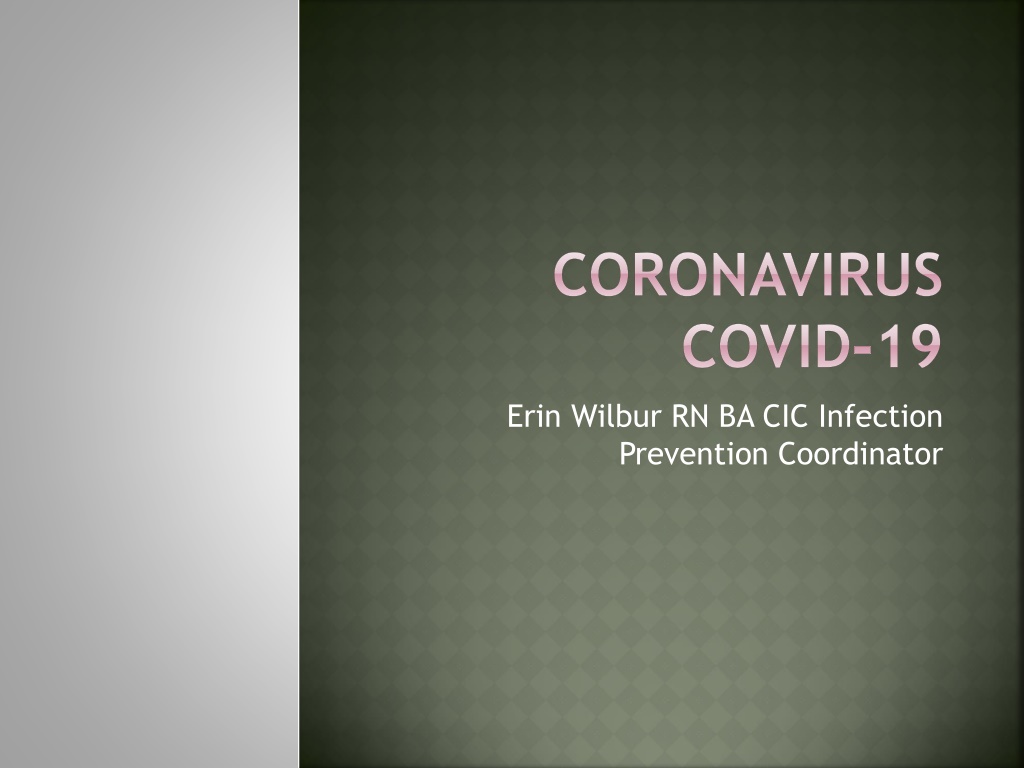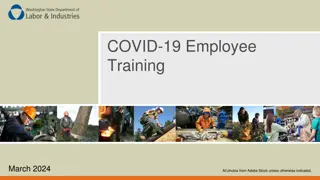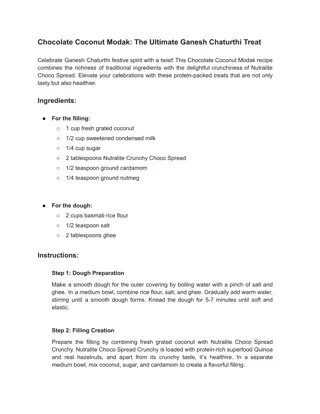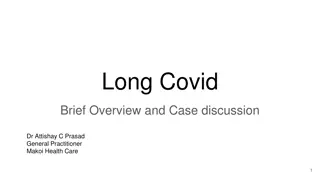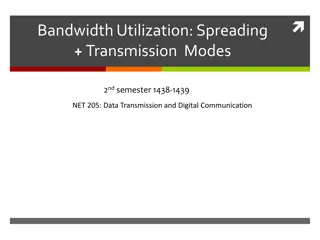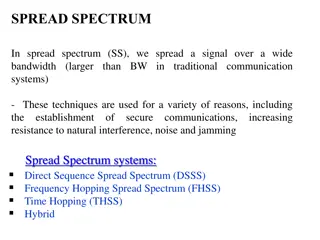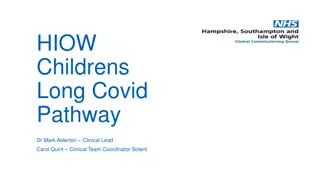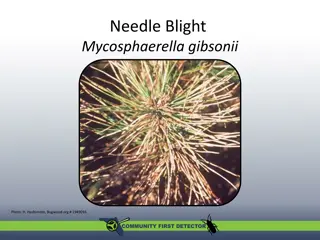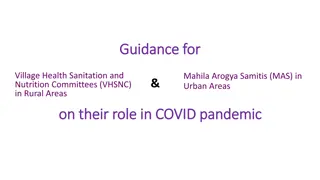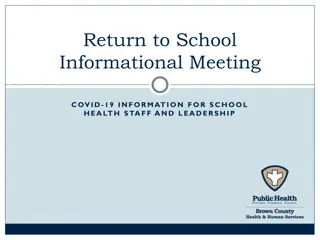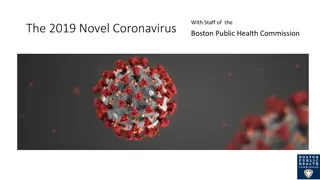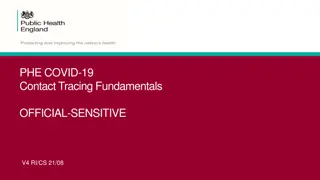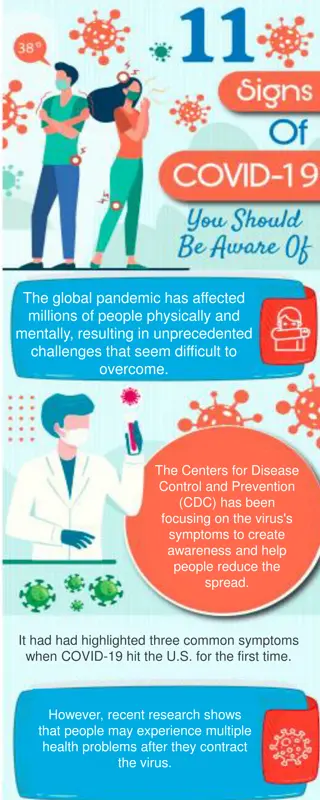Understanding COVID-19: Basics, Spread, Symptoms, and Evaluation Criteria
COVID-19 is caused by a novel coronavirus that spreads mainly person-to-person through respiratory droplets. Symptoms include fever and respiratory issues. Evaluation criteria help identify potential cases. Healthcare providers must stay vigilant and follow CDC guidelines to manage and prevent the spread of the virus.
Download Presentation

Please find below an Image/Link to download the presentation.
The content on the website is provided AS IS for your information and personal use only. It may not be sold, licensed, or shared on other websites without obtaining consent from the author. Download presentation by click this link. If you encounter any issues during the download, it is possible that the publisher has removed the file from their server.
E N D
Presentation Transcript
CORONAVIRUS COVID-19 Erin Wilbur RN BA CIC Infection Prevention Coordinator
WHAT IS COVID-19 Disease Basics A novel coronavirus is a new coronavirus that has not been previously identified. The virus causing coronavirus disease 2019 (COVID-19), is not the same as the coronaviruses that commonly circulate among humans and cause mild illness, like the common cold. A diagnosis with coronavirus 229E, NL63, OC43, or HKU1 is not the same as a COVID-19 diagnosis. Patients with COVID-19 will be evaluated and cared for differently than patients with common coronavirus diagnosis. Coronaviruses are a large family of viruses. Some cause illness in people, and others, such as canine and feline coronaviruses, only infect animals. Rarely, animal coronaviruses that infect animals have emerged to infect people and can spread between people. This is suspected to have occurred for the virus that causes COVID-19. The virus that causes COVID-19 is spreading from person to person. Someone who is actively sick with COVID-19 can spread the illness to others. That is why CDC recommends that these patients be isolated either in the hospital or at home (depending on how sick they are) until they are better and no longer pose a risk of infecting others.
HOW COVID-19 SPREADS The virus is thought to mainly spread person to person Between people who are in close contact with one another (within about 6 feet) Via respiratory droplets produced when an infected person coughs or sneezes. These droplets can land in the mouths or noses of people who are nearby or possibly be inhaled into the lungs. It may be possible that a person can get COVID-19 by touching a surface or object that has the virus on it and then touching their own mouth, nose, or possibly their eyes, but this is not thought to be the main way the virus spreads. Health care providers should obtain a detailed travel history for patients being evaluated with fever and acute respiratory illness. CDC guidance for evaluating and reporting a PUI for COVID-19 (person under investigation) remains unchanged.
Criteria to Guide Evaluation of Persons Under Investigation (PUI) for 2019-nCoV Clinical Features Fever or signs/symptoms of lower respiratory illness (e.g. cough or shortness of breath) & AND Epidemiologic Risk Any person, including health care workers, who has had close contact with a laboratory-confirmed 2019-nCoV patient within 14 days of symptom onset Feverand signs/symptoms of a lower respiratory illness (e.g., cough or shortness of breath) AND A history of travel from Hubei Province, China within 14 days of symptom onset Fever andsigns/symptoms of a lower respiratory illness (e.g., cough or shortness of breath) requiring hospitalization AND A history of travel from mainland China within 14 days of symptom onset Healthcare providers should immediately notify both infection control personnel at their healthcare facility and their local or state health department in the event of a PUI for 2019-nCoV. State health departments that have identified a PUI should immediately contact CDC s Emergency Operations Center (EOC) at 770-488-7100 and complete a 2019-nCoV PUI case investigation form. https://www.cdc.gov/coronavirus/2019-ncov/downloads/pui-form.pdf New York State Health Department after hours contact (866) 881-2809 Cayuga County Health Department (315) 253-1560 The criteria are intended to serve as guidance for evaluation. Patients should be evaluated and discussed with public health departments on a case-by-case basis. For severely ill individuals, testing can be considered when exposure history is equivocal (e.g., uncertain travel or exposure, or no known exposure) and another etiology has not been identified.
WHAT TO DO IF THERE IS A SUSPECTED COVID-19 PATIENT 1. Patient meets criteria at entrance to facility 2. If the patient meets criteria, ask the patient to put a mask on, immediately place the patient in a AIIR room (negative pressure). If the AIIR room is not available, the patient may remain in personal vehicle (outside the facility) if medically appropriate & can be notified by telephone or other remote way to enter for evaluation. 3. Infection Prevention, Nursing supervisor & Health Departments are notified 4. PPE placed outside patient room with isolation sign visible (GLOVES, GOWNS, N-95 MASKS/PAPR, EYE PROTECTION/FACE SHIELD. Adherence to Standard, Contact, and Airborne Precautions, Including the Use of Eye Protection 5. Hand hygiene supplies are easily accessible to patient room 6. Disinfectant wipes are available for patient room 7. Traffic in and out of patient room should be kept to a minimum. 8. Healthcare worker log and visitor log should be started 9. Direct clinical staff and Providers will begin their assessments, specimen collection and treatments. Specimen collection kit and procedures are available once criteria is met.
PPE Gloves Perform hand hygiene, then put on clean, non-sterile gloves upon entry into the patient room or care area. Change gloves if they become torn or heavily contaminated. Remove and discard gloves when leaving the patient room or care area, and immediately perform hand hygiene. Gowns Put on a clean isolation gown upon entry into the patient room or area. Change the gown if it becomes soiled. Remove and discard the gown in a dedicated container for waste or linen before leaving the patient room or care area. Disposable gowns should be discarded after use. Respiratory Protection Use respiratory protection. Disposable respirators should be removed and discarded after exiting the patient s room or care area and closing the door. Perform hand hygiene after discarding the respirator. If reusable respirators (e.g., powered air purifying respirator/PAPR) are used, they must be cleaned and disinfected according to manufacturer s reprocessing instructions prior to re-use. Eye Protection Put on eye protection (e.g., goggles, a disposable face shield that covers the front and sides of the face) upon entry to the patient room or care area. Remove eye protection before leaving the patient room or care area. Disposable eye protection should be discarded after use. YOU MUST BE FIT TESTED BY EMPLOYEE HEALTH TO ENTER THE PATIENT ROOM
CLEANING & DISINFECTION Implement Environmental Infection Control Dedicated medical equipment should be used for patient care. All non-dedicated, non-disposable medical equipment used for patient care should be cleaned and disinfected according to manufacturer s instructions and facility policies. Ensure that environmental cleaning and disinfection procedures are followed consistently and correctly. Routine cleaning and disinfection procedures should be done by clinical staff when caring for the patient in the room, minimal traffic to the room is recommended. Management of laundry, food service utensils, and medical waste should also be performed in accordance with routine procedures. Rooms must be shut down for a minimum of 2 hours after the patient is removed. The room will then be terminally cleaned according to hospital policy & procedure. EVS room cleaning will be done with all necessary PPE on. WIPE DOWN HIGH TOUCH POINT AREAS WHEN IN THE PATIENT ROOM
Prevention & Treatment There is currently no vaccine to prevent coronavirus disease 2019 (COVID-19). The best way to prevent illness is to avoid being exposed to this virus. However, as a reminder, CDC always recommends everyday preventive actions to help prevent the spread of respiratory diseases, including: Avoid close contact with people who are sick. Avoid touching your eyes, nose, and mouth. Stay home when you are sick. Cover your cough or sneeze with a tissue, then throw the tissue in the trash. Clean and disinfect frequently touched objects and surfaces using hospital approved disinfectant Follow CDC s recommendations for using a facemask. CDC does not recommend that people who are well wear a facemask to protect themselves from respiratory diseases, including COVID-19. Facemasks should be used by people who show symptoms of COVID-19 to help prevent the spread of the disease to others. The use of facemasks is also crucial for healthcare workers
When and How to Perform Hand Hygiene Multiple opportunities for hand hygiene may occur during a single care episode. Following are the clinical indications for hand hygiene: Use an Alcohol-Based Hand Sanitizer Immediately before touching a patient Before performing an aseptic task (e.g., placing an indwelling device) or handling invasive medical devices Before moving from work on a soiled body site to a clean body site on the same patient After touching a patient or the patient s immediate environment After contact with blood, body fluids or contaminated surfaces Immediately after glove removal Wash with Soap and Water When hands are visibly soiled After caring for a person with known or suspected infectious diarrhea After known or suspected exposure to spores (e.g. B. anthracis, C difficile outbreaks)
QUESTIONS? CONTACT INFECTION PREVENTION AT EXT. 1834 https://www.cdc.gov/coronavirus/201 9-ncov/index.html
